25 Metrics to Track in a Product-Led SaaS Company

Published 2023-09-26
Summary - How to track performance in a product-led SaaS company with 25 key metrics.
- Metric definitions powered by MetricHQ -
Product is the primary way you acquire, expand, and retain customers.
...and every team in your company is organized to leverage this.
... and every win, and every loss, and every click creates data. Listen. It's not optional.
In a product-led company, your product is the primary way you acquire, expand, and retain customers.
Every win, every loss, and every click creates data. It’s important that we listen to what the data is telling us, discover new insights, and use them to guide our actions.
The best way to listen to our data is to build metrics with it and track those metrics in real-time.
Here are 25 key metrics to track in a product-led company:
1. Website New Users
2. Marketing Qualified Leads (MQLs)
3. MQL To SQL Conversion Rate
4. Customer Acquisition Cost (CAC)
5. Lead To Win Rate
6. Average New MRR
7. Won Customers
8. Net Promoter Score (NPS)
9. Lifetime Value (LTV)
10. Net Churn Rate
11. True Trial Engagement
12. Average Server Response Time
13. Logo Churn or Logo Retention
14. Active Users per Account
15. Product Performance
16. Bugs
17. Revenue
18. Net Burn
19. Current Ratio
20. Time To Fill
21. Employee Turnover Rate
22. Revenue / Expenses per Full Time Equivalent (FTE)
23. Cost Per Hire
24. CAC Payback Period
25. Revenue Retention Rate
These 25 metrics belong to five different departments within a product-led company; Marketing, Sales, Product, Finance, and HR.
This article will explain each metric in detail and show you how to track them in a way that drives better decision making in your individual teams and product-led company as a whole.
It’s important to note that a metric must be intimately connected with a key business objective. So, for each team below you will see a number of departmental objectives that the metrics directly relate to.
First off, let’s take a look at what it means to be a product-led company.
What is a product-led company?
Allan Wille, Co-Founder and Chief Innovation Officer at the product-led company, Klipfolio describes a product-led company as one where
“…product is the primary way you acquire, expand, and retain customers.”

Check out this episode of the ‘Product Led Podcast’ to hear more of Allan’s thoughts on what it means to work in and lead a product-led SaaS company.
In order to ensure your product-led company is on the right track and growing every day, it’s crucial that every team understands their objectives, goals, and data trends at all times.
Here are the top 25 metrics for product-led companies broken down by department:
4 key metrics for marketing teams in product-led companies:
Website New Users: The count of users that visit your site for the first time. Google Analytics assigns a unique identifier to each user. Unless the user clears their cookies or uses a new device unknown to Google, this unique identifier is how Google knows if this is a new or returning user.
Marketing Qualified Leads (MQLs): A Marketing Qualified Lead is a universal metric used by marketing teams to measure the quality of leads they generate and pass to sales. Most marketing teams have targets associated with MQLs that include number of MQLs and acceptance rate, for example, leads that go on to become Sales Accepted Leads.
MQL To SQL Conversion Rate: MQL to SQL conversion rate is the percentage of marketing qualified leads that are successfully converted into sales qualified leads.
Customer Acquisition Cost (CAC): Customer Acquisition Cost (CAC) is the cost a business incurs to acquire a new customer. This includes the fully loaded costs associated with sales and marketing to attract a potential customer and to convince them to purchase.
4 main objectives for marketing teams in product-led companies:
Generate high-quality top-of-funnel traffic.
Build intent through compelling and educational content.
Increase overall trial start velocity.
Obsess about funnel efficiency.
Here’s the best way to display and monitor your marketing metrics and objectives:
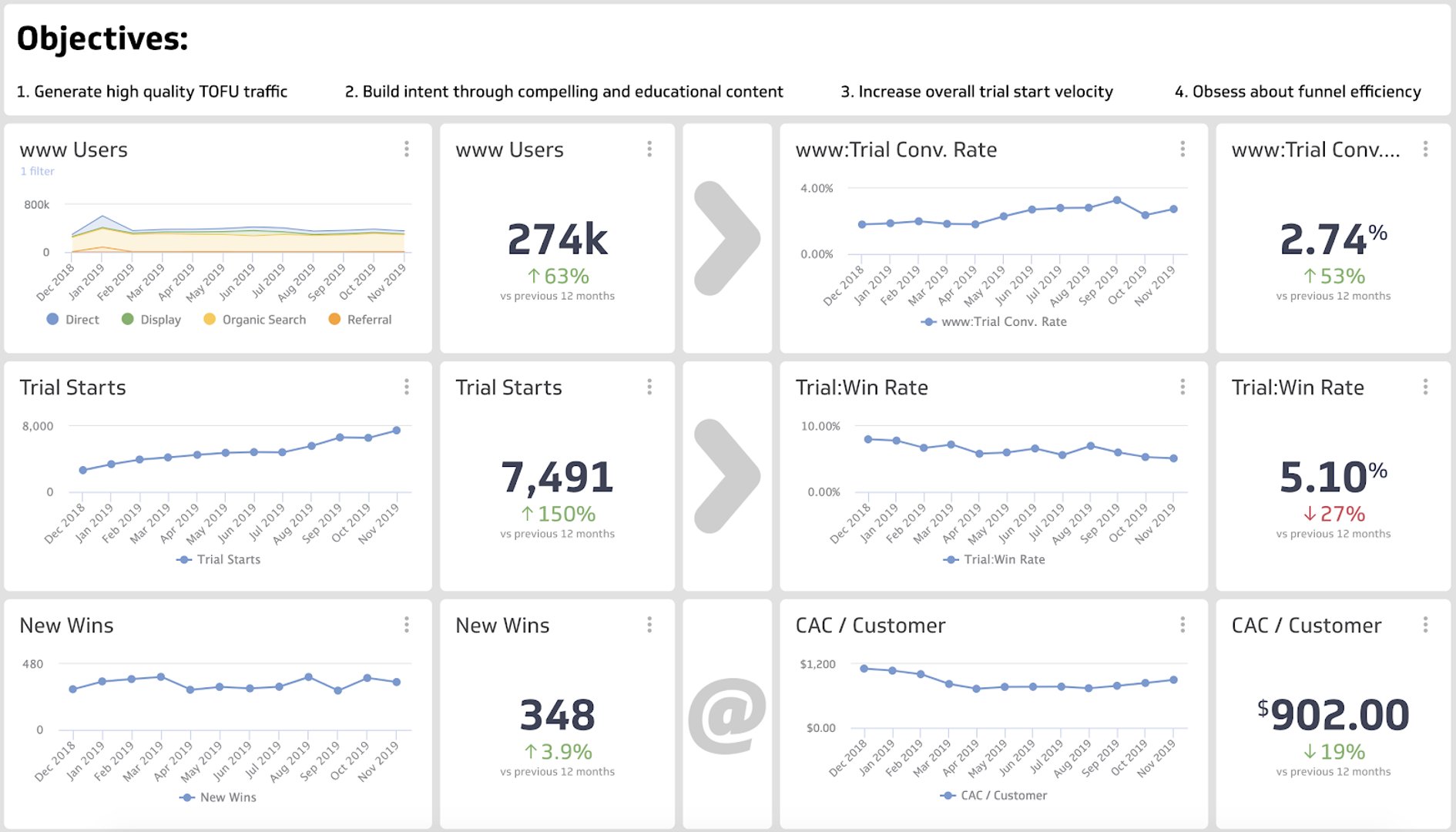
6 key metrics for sales teams in product-led companies:
Tracking Acquisition
Lead to Win Rate: Lead To Win Rate is the percentage of Leads who entered the sales funnel and are now “Closed Won” Customers. This is one of the most ubiquitous sales conversion metrics and is a strong indication of product-market fit, pricing, and sales execution. It’s also a key metric in aligning your marketing, sales, and product teams.
Average New MRR: Monthly Recurring Revenue (MRR) is the sum of all subscription revenue expressed as a monthly value. For most companies, MRR is the sum of all new business subscriptions and upgrades (sometimes called expansion), minus downgrades (or contractions) and cancelled subscriptions. Though not a Generally Accepted Accounting Principle (GAAP) value, it’s the Revenue equivalent used by every SaaS company. MRR is used interchangeably with ARR.
Won Customers: Won Customers is the count of new accounts in the sales funnel that are “Closed Won”. It is a measure of success of the Sales and Marketing teams. “Closed Won” is the stage at which a prospect has signed or electronically accepted a contract and is now considered a customer. Counter to Won Opportunities, Won Customers only applies to the Account once, whereas you can have multiple Opportunities per Account.
Tracking Account Management
Net Promoter Score (NPS): Net Promoter Score or NPS® is a measure of a customer base’s willingness to promote a product or service to colleagues and friends. It is based on the results of a current customer survey, which asks respondents to answer the following question: “how likely is it that you would recommend (brand or product X) to a friend or colleague?”
Lifetime Value (LTV): The Customer Lifetime Value (LTV) metric indicates the total revenue a business can reasonably expect from a single customer account. It considers a customer’s revenue value and compares that number to the company’s predicted customer lifespan. Businesses use this metric to identify their most valuable customer segments.
Net Churn Rate: Net Monthly Recurring Revenue (MRR) Churn Rate is the percentage change in MRR due to expansions, cancellations, and downgrades. A negative Net MRR Churn Rate occurs when expansions exceed downgrades and cancellations and is a strong positive indicator of company health. This metric is typically expressed as a monthly rate although it can also be an annual rate: Net Annual Recurring Revenue (ARR) Churn Rate.
6 main objectives for sales teams in product-led companies:
Acquisition Objectives
Focus on high-quality leads.
Follow through on early customer onboarding.
Be a true product expert and listen.
Account Management Objectives
Engage with high-value accounts driving usage and expansion.
Work with partners to build their business and drive usage with their clients.
Provide product teams with field feedback and access to customers for learning.
Here’s the best way to display and monitor your sales metrics and objectives:
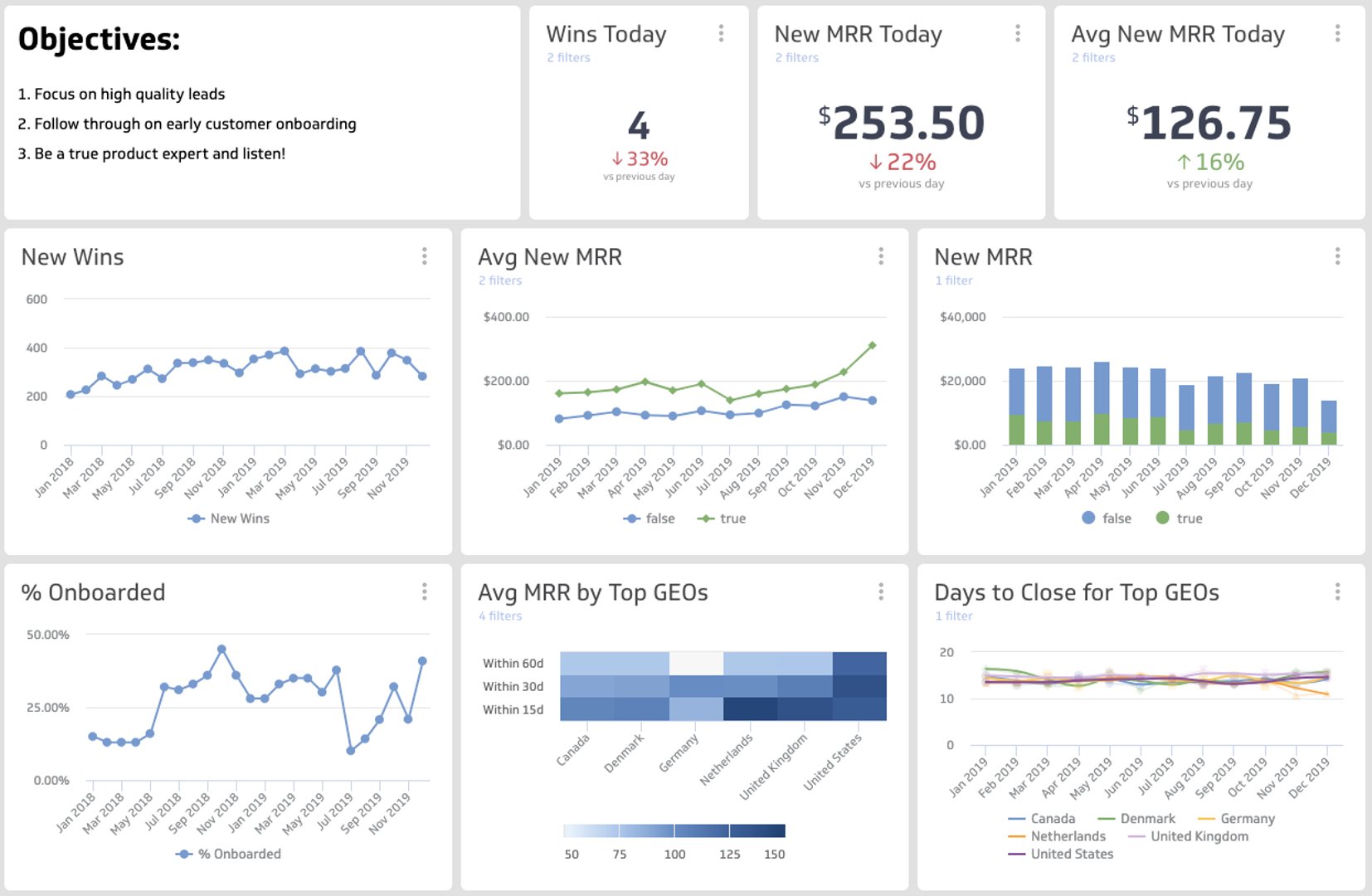
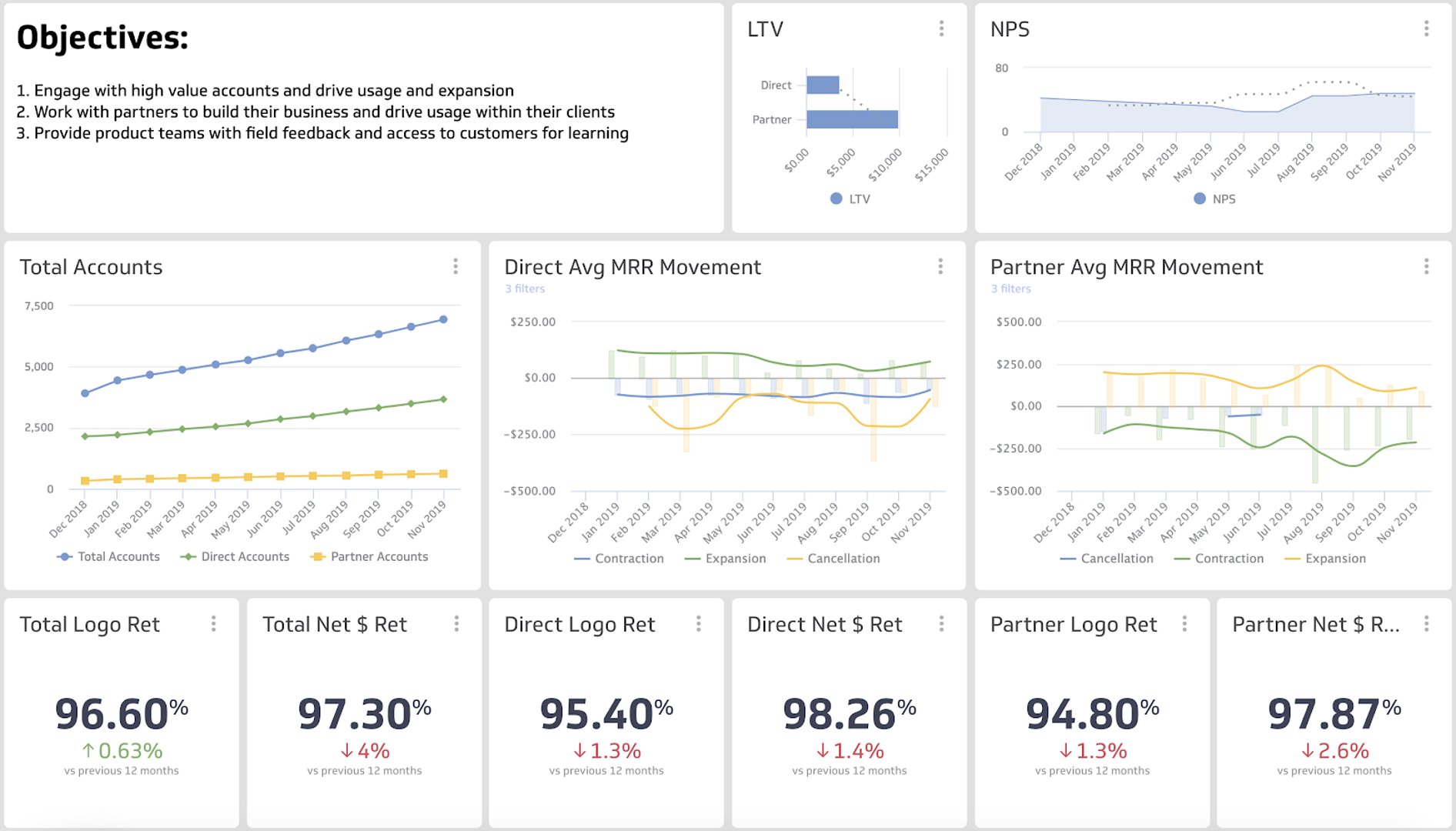
6 key metrics for product teams in product-led companies:
True Trial Engagement: A True Trial is defined as a user who starts a trial and comes back a second time within the first 7 days. The True Trials metric is meaningful for any software company that offers prospects a trial before they choose to buy. Prospects who sign in twice within the first 7 day period are more likely to become paying customers. Tracking True Trials enables you to assess lead quality, product engagement, and probability of a win much earlier than only looking at Win Rate.
Average Server Response Time: Average Server Response Time is the average amount of time an application’s web server takes to return the results of a request to the user. It is affected by several factors including network bandwidth, number of users, and number and type of requests submitted.
Logo Churn or Logo Retention: Logo Churn is the enemy of any subscription company. Logo Churn is the number or percentage of subscribers to a service that discontinue their subscription to that service in a given time period.
Active Users per Account: The total number of unique users that log in to their own account.
Product Performance: The Product Performance KPI ranks product sales based on revenue performance to inform your sales team which products are selling well. At the same time, you should rank the poorest performing products to determine which products are failing to resonate with your customers.
Bugs: A product team should always keep an eye on its bug pool. It is easy, and sometimes demanded by stakeholders, to only focus on feature development and go after the next shiny object. However, you have to always know where you are with respect to quality. You should segment this metric by components and/or services, severity (critical, major, normal), type (performance, usability, security) and any other dimension that helps teams prioritize them and find where the big clusters of bugs are and where they need to focus.
4 main objectives for product teams in product-led companies:
Improve trial conversion rates.
Drive engagement and expansion revenue.
Support the partner ecosystem.
Deliver performance, quality, and security.
Here’s the best way to display and monitor your product metrics and objectives:
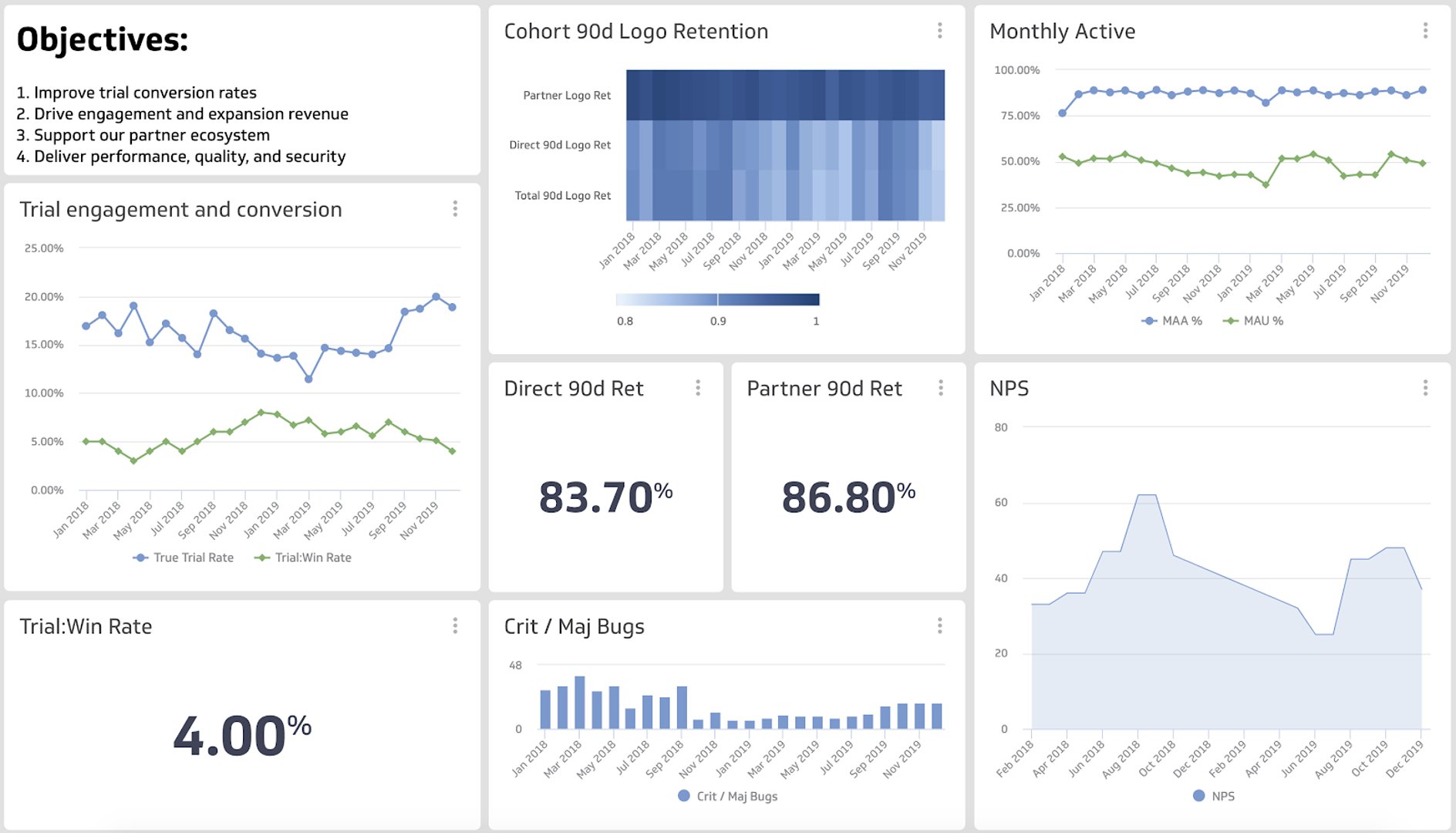
3 key metrics for finance teams in product-led companies:
Revenue: Revenue is the income generated through a business’ primary operations, such as the sale of products or services, or proceeds from rent or interest, less any discounts or returns.
Net Burn: Net Burn is the amount a company is losing per month as they burn through their cash reserves. It occurs when a company’s operating costs are higher than their revenue. A company that is profitable and generating cash has a “negative Net Burn”.
Current Ratio: Current Ratio measures the ability of your organization to pay all of your financial obligations in one year. This ratio accounts for your current assets, such as accounts receivable, and your current liabilities, such as accounts payable, to help you understand the solvency of your business. Generally speaking, a ratio between 1.5 and 3 is preferable and indicates strong financial performance.
3 main objectives for finance teams in product-led companies:
Refine business model and understanding of levers.
Increase efficiency through automation.
Work towards a single source of true financial data.
Here’s the best way to display and monitor your finance metrics and objectives:
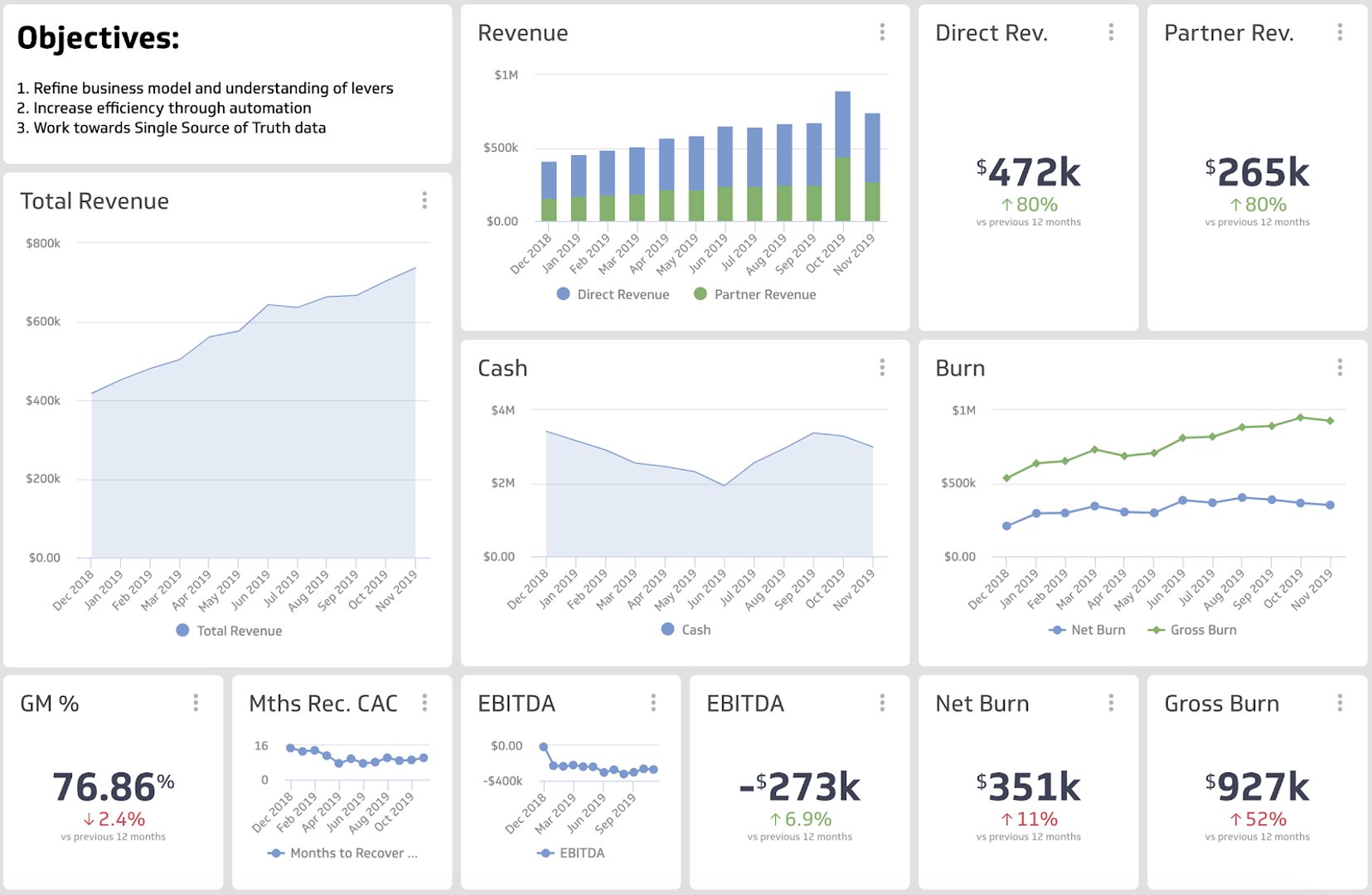
5 key metrics for HR teams in product-led companies:
Time To Fill: Time to Fill is the amount of time it takes a Human Resources Team to fill an open position. It can indicate where HR teams can make process improvements. It can also demonstrate changes in the hiring market.
Employee Turnover Rate: Employee Turnover Rate is the percentage of employees who voluntarily or involuntarily leave an organization (typically calculated annually). You should consider voluntary and involuntary categories separately, in addition to looking at overall Employee Turnover Rate.
Revenue / Expenses per Full Time Equivalent (FTE): Full-Time Equivalents (FTE) is a calculated metric that adds all of the true full-time employees to the fractional values for all part-time employees, contractors, students and interns. From a financial point of view, knowing what your FTE number is, allows you to more easily calculate a variety of performance metrics, such as Revenue per FTE.
Cost Per Hire: Cost Per Hire is a fundamental recruiting metric, that helps Human Resource professionals budget, calculate a return on their effort, and understand how effective their employee brand is when recruiting talent. Cost Per Hire is defined as the internal and external costs required to hire a new employee.
CAC Payback Period: CAC Payback Period is the time it takes for a customer to pay back their customer acquisition costs. The value depends on how high the Customer Acquisition Cost (CAC) is and how much a customer contributes in revenue each month or each year.
Revenue Retention Rate: Monthly Recurring Revenue (MRR) Renewal Rate is the percentage of MRR retained from existing customers, calculated using expansion MRR, downgrades, and cancels.
4 main objectives for HR teams in product-led companies:
Maintain culture and engagement.
Encourage diversity and inclusion.
Retain employees.
Recruit and hire great people.
Here’s the best way to display and monitor your HR merics and objectives:
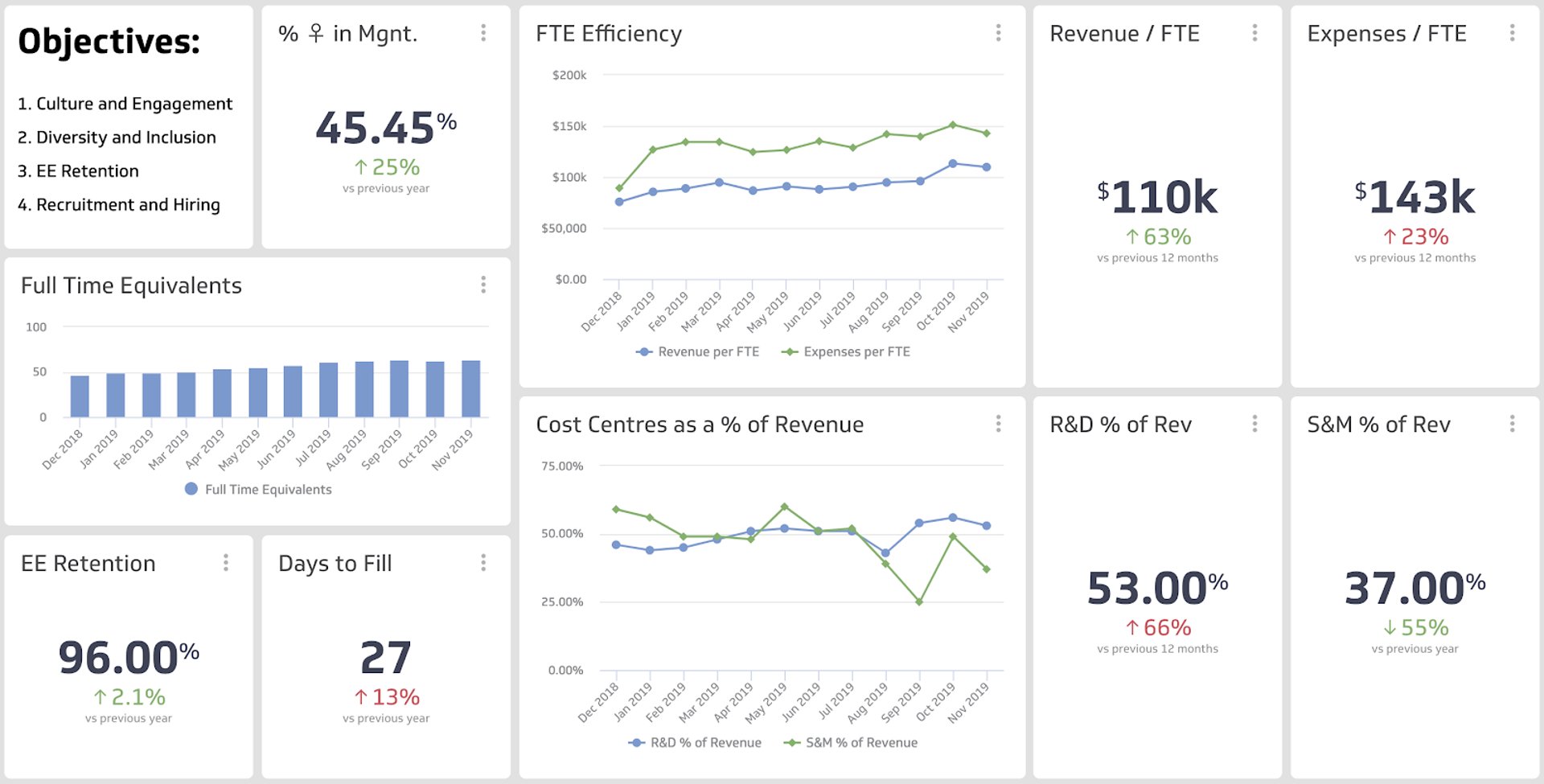
The best way to share your metrics
TV wallboards are a great way to have your metrics available at-a-glance when you are on your way to a meeting or to grab a coffee. They make a great place for standup meetings as well.
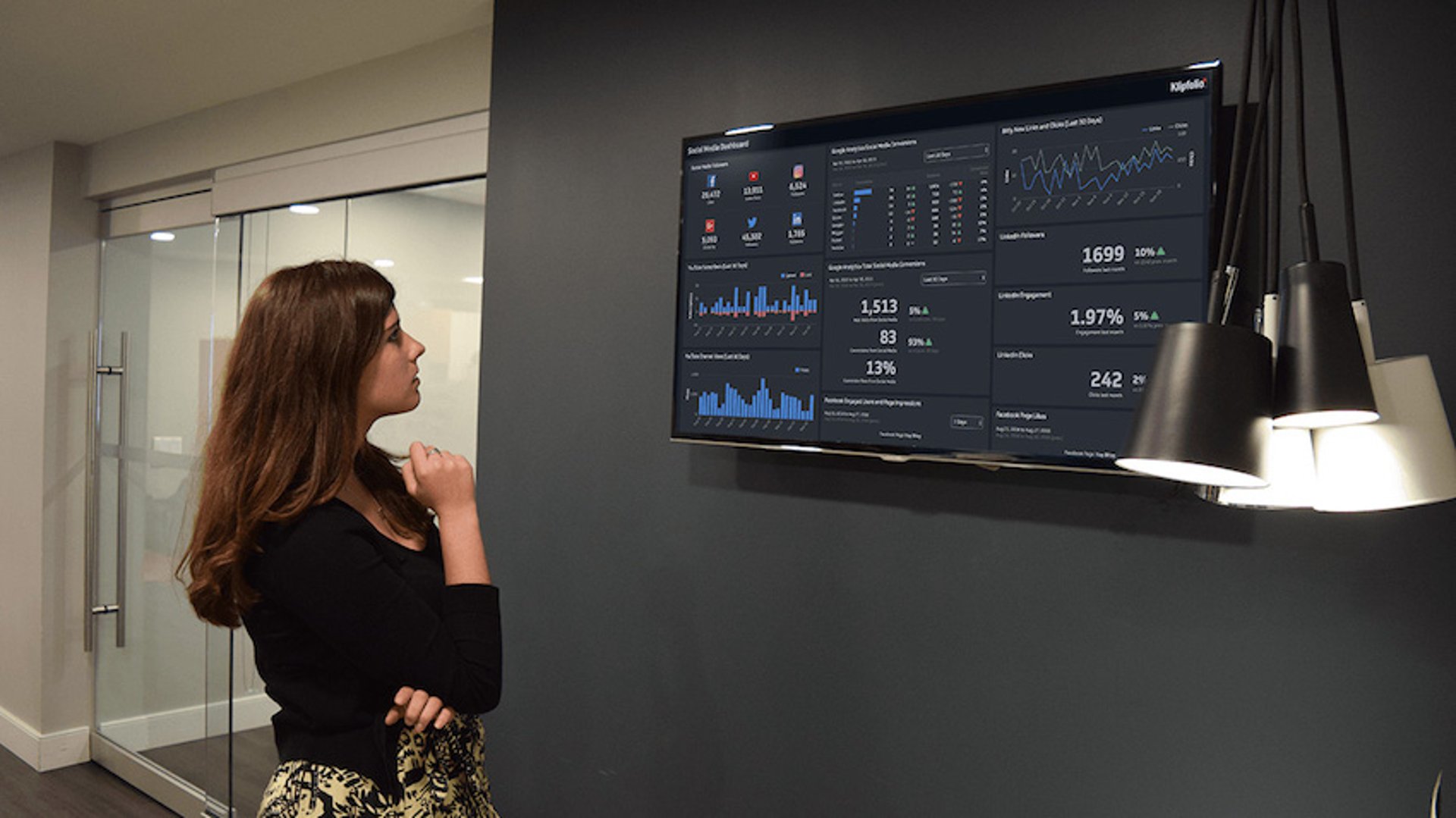
You can view your dashboards on virtually any mobile device through the Klipfolio App and you can even have your dashboard reports emailed to anyone in PDF format.

The key is to share the reports that matter with the people that matter so you can drive better decision making and succeed with data.
Related Articles

Promoting data literacy with metrichq.org and the power of AI
By Allan Wille, Co-Founder — October 12th, 2023
Let’s fix analytics so we can stop asking you for dashboards
By Cathrin Schneider — September 11th, 2023
Why metrics are the key to confident decision making
By Graham Watts — July 31st, 2023

